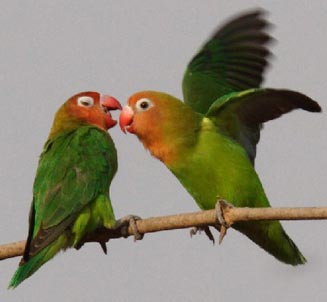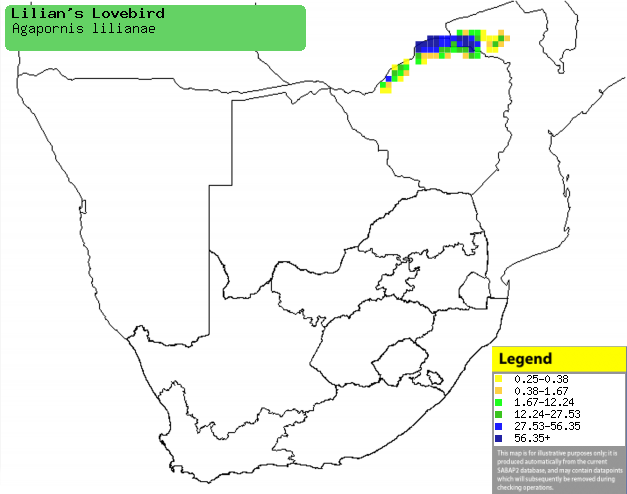|
Agapornis lilianae (Lilian's
lovebird)
Njassaparkiet [Afrikaans]; Poro (generic term for
lovebirds) [Kwangali]; Nyasa-agapornis [Dutch]; Inséparable de Lilian [French];
Erdbeerköpfchen [German]; Inseparável do Niassa [Portuguese]
Life
> Eukaryotes >
Opisthokonta
> Metazoa (animals) >
Bilateria >
Deuterostomia > Chordata >
Craniata > Vertebrata (vertebrates) > Gnathostomata (jawed
vertebrates) > Teleostomi (teleost fish) > Osteichthyes (bony fish) > Class:
Sarcopterygii (lobe-finned
fish) > Stegocephalia (terrestrial
vertebrates) > Tetrapoda
(four-legged vertebrates) > Reptiliomorpha > Amniota >
Reptilia (reptiles) >
Romeriida > Diapsida > Archosauromorpha > Archosauria >
Dinosauria
(dinosaurs) > Saurischia > Theropoda (bipedal predatory dinosaurs) >
Coelurosauria > Maniraptora > Aves
(birds) >
Order: Psittaciformes > Family: Psittacidae
 |
|
|
Lilian's lovebird, South Luangwa, Zambia. [photo
Philip Perry
©] |
|
The Lilian's lovebird mainly occurs in a small area from
Zimbabwe to Zambia and Mozambique, preferring mature Mopane (Colosphermum
mopane) woodland and riparian forest. It mainly eats grass seeds, but it may
also feed on agricultural crops, flowers and fruit. It is highly sociable and
gregarious, foraging on the ground in flocks of up to 600 birds! Its breeding
habits are little known in the wild - it is thought to be a monogamous, loosely
colonial nester. It mainly nests in natural tree cavities, where it lays about
4-5 eggs, which are incubated solely by the female for about 22 days. The chicks
are cared for by both parents, staying in the nest for about 44 days.
Distribution and habitat
Occurs in a small area from
south-eastern Zambia to northern Zimbabwe and north-western Mozambique. It is
locally common to abundant, generally preferring mature Mopane (Colosphermum mopane)
woodland and riparian forest, especially with fig (Ficus) trees.
|
 |
|
Distribution of Lilian's lovebird in southern Africa,
based on statistical smoothing of the records from first SA Bird Atlas
Project (©
Animal Demography unit, University of
Cape Town; smoothing by Birgit Erni and Francesca Little). Colours range
from dark blue (most common) through to yellow (least common). |
Call
Food
Eats mainly grass seeds, but it may
also feed on agricultural crops, flowers and fruit. It is highly sociable and
gregarious, foraging on the ground in flocks of up to 600 birds! The following
food items have been recorded in its diet:
- Plants
- seeds
- grass
- Oryza perennis (Wild rice)
- Hyparrhenia (thatching grass)
- agricultural crops
- flowers
- Faidherbia albida (Ana-tree)
- Erythrophleum africanum (Ordeal-tree)
- Vitex (fingerleafs)
- Cordyla africana (Wild-mango)
- Combretum paniculatum (Forest burning-bush combretum)
- leaves and fruit
- Ficus bussei (Zambezi fig)
Breeding
- Its breeding habits are little known in the wild - it
is thought to be a monogamous, loosely colonial nester.
- Typically nests in natural tree cavities (especially in Colosphermum
mopane (Mopane), however in captivity both sexes build a domed
structure but this has not been recorded in the wild.
- Egg-laying season is from about January-April.
- It lays about 4-5 eggs, which are incubated solely by the female for
about 22 days.
- The chicks are cared for by both parents, staying in the nest for about
44 days.
Threats
Not threatened.
References
-
Hockey PAR, Dean WRJ and Ryan PG (eds) 2005. Roberts
- Birds of southern Africa, VIIth ed. The Trustees of the John Voelcker
Bird Book Fund, Cape Town.
|
